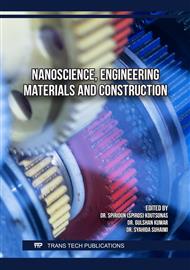[1]
Ma, M.X. et al. (2014). Study on Rubber Seal Design of a Swellpacker in Oil Well Cementing. OALib, 1(9), 1-8.
DOI: 10.4236/oalib.1101082
Google Scholar
[2]
Ma, W.G. et al. (2014). Effect of the friction coefficient for contact pressure of packer rubber. Proceedings of the Institution of Mechanical Engineers Part C-Journal of Mechanical Engineering Science, 228 (16), 2881-2887.
DOI: 10.1177/0954406214525596
Google Scholar
[3]
Zhang, F.Y. et al. (2018). Mechanical analysis of sealing performance for compression packer rubber tube. Mechanics & Industry, 19 (3), 1-9.
Google Scholar
[4]
Lan, W.J. et al. (2019). Sealing properties and structure optimization of packer rubber under high pressure and high temperature. Petroleum Science, 16 (3), 632-644.
DOI: 10.1007/s12182-018-0296-0
Google Scholar
[5]
Hu, G. et al. (2018). Study on sealing capacity of packing element in compression packer. Journal of the Brazilian Society of Mechanical Sciences and Engineering, 40 (9), 1-19.
Google Scholar
[6]
Liu, Y. & Lian, Z. (2019). Design and experimental research on sealing structure for a retrievable packer. SHOCK AND VIBRATION, 2020, 1-15.
Google Scholar
[7]
TRELOAR, L.R.G. (1943). Stress strain data for vulcanised rubber under various types of deformation. Journal of the Chemical Society, 40 (59), 59-70.
DOI: 10.1039/tf9444000059
Google Scholar
[8]
TRELOAR, L.R.G. (1945). THE ELASTICITY OF A NETWORK OF LONG-CHAIN MOLECULES.3. J Chem Physics, 42 (2), 84-94.
Google Scholar
[9]
Hu, X.L. & Liu, X.& Z M. & Luo, W.B. (2014). Selection strategies of hyperelastic constitutive models for carbon black filled rubber. Eng. Mech. 31, 34–42 . (In Chinese)
Google Scholar
[10]
Kuang, Y.C. et al. (2023). Research on Yeoh-Revised hyperelastic constitutive model considering the volume almost incompressible premise for rubber materials. Journal of Elastomers & Plastics, 55 (7), 1123-1151
DOI: 10.1177/00952443231196279
Google Scholar
[11]
Wei, J.W. et al. (2022). Strain Rate Dependent Constitutive Model of Rubber. Chinese Journal of High Pressure Physics, 36 (2), 024205
Google Scholar
[12]
Sasso, M. et al. (2008). Characterization of hyperelastic rubber-like materials by biaxial and uniaxial stretching tests based on optical methods. Polymer Testing, 27(8), 995-1004.
DOI: 10.1016/j.polymertesting.2008.09.001
Google Scholar
[13]
Ghoreishy, M.H.R. (2012). Determination of the parameters of the Prony series in hyper-viscoelastic material models using the finite element method. Materials & Design, 35, 791-797.
DOI: 10.1016/j.matdes.2011.05.057
Google Scholar
[14]
Lev, Y. et al. (2019). Thermoelastic deformation and failure of rubberlike materials. Journal of the Mechanics and Physics of Solids, 122, 538-554.
DOI: 10.1016/j.jmps.2018.09.033
Google Scholar
[15]
Gent, A.N. (2005). Elastic instabilities in rubber. International Journal of Non-Linear Mechanics, 40 (2), 165-175.
DOI: 10.1016/j.ijnonlinmec.2004.05.006
Google Scholar
[16]
Rivlin, R.S. & Saunders, D.W. (1951). Large elastic deformations of isotropic materials VII. Experiments on the deformation of rubber. Philos Trans R Soc London A, 243, 251-288.
DOI: 10.1098/rsta.1951.0004
Google Scholar
[17]
Chaves, E.W.V. (2013). Notes on Continuum Mechanics. In International Center for Numerical Methods in Engineering (CIMNE). Springer: Barcelona, Spain.
Google Scholar
[18]
Abaqus 6.14. (2014) Theory Guide. Hyperelastic material behavior. http://130.149.89.49:2080 /v6.14/books/stm /default. htm.
Google Scholar
[19]
OGDEN, R.W. (1972). Large deformation isotropic elasticity – on the correlation of theory and experiment for incompressible rubberlike solids. Proc R Soc Lond A, 326 (1567), 565–584.
DOI: 10.1098/rspa.1972.0026
Google Scholar
[20]
Lehr, D.J. & Collins, S.D. (2015). The High-Pressure High-Temperature Completion Landscape--Yesterday, Today, and Tomorrow. SPE Drilling & Completion, 187-197.
DOI: 10.2118/170919-pa
Google Scholar
[21]
Zhao, L. & Xu, Z. (2018). Carbon Nanocomposite for Reliable Seal Applications in High-Temperature, High-Pressure, Corrosive Environments. TMS 2018 147th Annual Meeting & Exhibition Supplemental Proceedings, 777-785.
DOI: 10.1007/978-3-319-72526-0_73
Google Scholar
[22]
Deng, G. et al. (2018). The ultra-expansion completion packer integrated with additive manufacturing Technology. Society of Petroleum Engineers, 1-11.
Google Scholar
[23]
Hu, G. et al. (2017). The influence of rubber material on sealing performance of packing element in compression packer. Journal of Natural Gas Science and Engineering, 38, pp.120-138.
DOI: 10.1016/j.jngse.2016.12.027
Google Scholar
[24]
Zhou, C. et al. (2017). Sealing performance analysis of rubber O-ring in high-pressure gaseous hydrogen based on finite element method. International Journal of Hydrogen Energy, 42 (16), 11996-12004.
DOI: 10.1016/j.ijhydene.2017.03.039
Google Scholar
[25]
Zhou, C. et al. (2018). Finite Element Analysis of Sealing Performance of Rubber D-Ring Seal in High-Pressure Hydrogen Storage Vessel. Journal of Failure Analysis and Prevention, 18 (4), 846-855.
DOI: 10.1007/s11668-018-0472-y
Google Scholar
[26]
Yang, X.J. et al. (2006). Frictional contact analysis of packer rubber with large deformation based on adhesive slip friction contact method. Mechanical Strength, 28 (2), 229-234. (in Chinese)
Google Scholar
[27]
Qu, B.L. et al. (2015). Optimal design of packer casing based on friction factor. China Petroleum Machinery, 43(2), 83-87. (in Chinese)
Google Scholar
[28]
Chen, S.Q. et al. (2019). Contact Mechanical behavior and Setting effect evaluation of compression Packer. Journal of Xi 'an Shiyou University (Natural Science Edition), 34 (4), 82-88. (in Chinese)
Google Scholar
[29]
Zhao, Y.P. et al. (2016). Analysis of failure factors and countermeasures of casing packer during completion testing. Technical Supervision of Petroleum Industry, 32 (4), 52-56. (in Chinese)
Google Scholar


